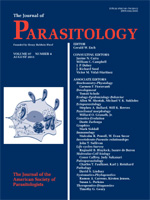Extracted DNA from 28 Histomonas meleagridis-infected avian tissue samples from multiple hosts and geographic locations was analyzed for variation in the 5.8S rRNA and the flanking internal transcribed spacer regions (ITS 1 and ITS 2). Samples were amplified by polymerase chain reaction, sequenced, and compared with known sequences from GenBank accessions of H. meleagridis and other related protozoa. The analyses revealed significant genetic variation within H. meleagridis sequences and suggested the possibility of multiple genotypes within the samples or a possible misdiagnosis. Related protozoa found in some samples were mostly identified as Tetratrichomonas spp. However, 1 sample had a 93% identity to Simplicimonas similis, a newly described organism, suggesting the possibility of a new pathogen in poultry. A phylogenetic tree analyzing the 5.8S and flanking ITS regions was inconclusive and we were unable to resolve all H. meleagridis into a single grouping. In contrast, a tree constructed only on the 5.8S rRNA grouped all but 1 H. meleagridis sample into 1 clade, including GenBank accessions submitted from Europe. This suggests that the 5.8S region alone is more reliable in identifying H. meleagridis than are the combined 5.8S and flanking ITS regions. There was no correlation between genotypes and host species or geographic location, suggesting that H. meleagridis moves freely between multiple avian species in the sampled regions.
How to translate text using browser tools
1 August 2011
Molecular Characterization of Histomonas meleagridis and Other Parabasalids in the United States Using the 5.8S, ITS-1, and ITS-2 rRNA Regions
Lori Lollis,
Richard Gerhold,
Larry McDougald,
Robert Beckstead
ACCESS THE FULL ARTICLE

Journal of Parasitology
Vol. 97 • No. 4
August 2011
Vol. 97 • No. 4
August 2011




